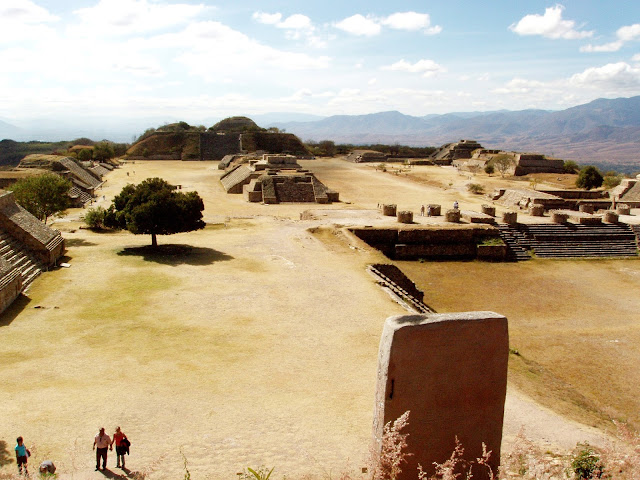Empezamos
a notar las reparaciones por primera vez hace dos años.
Banquetas donde nos habíamos
acostumbrado a esquivar agujeros traicioneros o tornillos medio
escondidos de repente fueron arregladas. Las reparaciones siempre
fueron esmeradas, limpias y solidas, etiquetadas a mano con la
inscripción
“Gpo. Salvando Vidas Oaxaca.”
No
importa si es nuevo en Oaxaca o ha vivido aquí
por años,
ciertamenta ha notado, quejado, o quizás
se ha lastimado transitando las notoriamente agrietadas, rotas y
obstaculizadas banquetas de la ciudad. Las banquetas no parecen ser
la responsibilidad de nadie; claro, el municipio no las repara, ni
los dueños
de casas ni negocios. Si usted es como nosotros, probablemente se ha
encogido de hombros; decidió
que así
es como está
aquí, y aprendió
a caminar con mucho cuidado.
Pero
evidentemente no era el caso con este Gpo. Salvando Vidas Oaxaca,
quienquiera que fueran. Teníamos curiosidad, pero no suficiente para
que los rastreáramos hasta este año, cuando nos encontramos otra
reparación, pero esta vez con un número de teléfono añadido a la
inscripción.
Una
de las más de 200 reparaciones hechas por el Gpo. Salvando Vidas
Oaxaca, A.C.
Llamamos
al número y hablamos con un hombre muy agradable quien nos explicó
que sí, él era el jefe del
grupo, y que él
y su esposa estarían encantados de conocernos y contarnos sobre su
trabajo. Arreglamos una cita para tomar un café unos días más
tarde.
Aprendemos
que este grupo para salvar vidas y extremidades es en gran medida us
asunto de familia. El padre de familia, Manuel Chávez
Núñez,
nos dijo que se le ocurrió
la idea en marzo de 2014, cuando vio a una persona discapacitada caer
por falta de una coladera. Viendo a la persona herida siendo llevada
en una ambulancia, decidió
que era necesario hacer algo para proteger a otros peatones.
Platicaba con su familia—su esposa Ángeles
San Juan y sus hijos, Carolina, de 23, y Manuel, de 20—presentando
la de idea como algo que ellos pueden hacer juntos para ayudar a
otros. “Somos una familia muy cercana, caseros realmente,” dice
Manuel. Entonces vino naturalmente a ellos asumirlo como un proyecto
familiar.
Cubrir
el lugar peligroso que ha mandado la persona discapicitada al
hospital resultó
ser nada mas que la primera de muchas reparaciones parecidas—¡hasta
ahorita más
de que 200! Decir que esta familia es de Buenos Samaritanos ni
siquiera empieza a hacerles justicia.
“Una
vez que habíamos
empezado, nos dimos cuento de que hay muchos, muchos lugares que
necesitan reparaciones,” dice Manuel. “Nos hemos convertido en
'policía
de la calle,' siempre buscando obstáculos
que son peligrosos para peatones.”
Al
principio, mantuvieron un perfil bajo, no seguros de como las
autoridades reaccionarían.
Pero eventualmente hablaron con el gobierno municipal para ver o si
podían conseguir que el
gobierno asumiera responsibilidad para las reparaciones necesarias o
al menos para asegurarse de que no se meterían
en problemas debido a sus trabajos.
“Si
el gobierno nos manda dejarlo, lo dejaremos,” dice Manuel. “En
teoría, es la
responsibilidad de la ciudad. Pero nos dejaron claro que no tenían
los recursos para hacer lo que estabamos haciendo. Habría
sido un problema si se hubieran opuesto, pero en lugar nos dijeron
'adelante.'”
Manuel
y Ángeles están
decepcionados de que el gobierno municipal no haga lo que debe hacer,
pero se niegan a estar enojados. “No estamos
contra el gobierno,” dice Manuel. “No vale estar en contra de
algo o alguien. En lugar, decimos que el gobierno nos ha dado la
oportunidad, como ciudadanos, de tomar acción.”
Cuando
quedó claro que este
asunto iba a ser un proyecto grande y continuo, y que de vez en
cuando las personas fuera de la familia estarían
involucradas como voluntarias, decidieron formalizer el grupo como
Asociación Civil, o A.C.
Manuel nos mostró el paquete
grueso de papeles que define los derechos y responsibilidades de la
asociacion. “Pagamos por el acta constitutiva para que tuviéramos
el derecho legal de actuar para beneficiar a la comunidad,” dice
Manuel.
El
trabajo que hacen no es fácil ni barato. Ellos donan su tiempo y
mano de obra, al igual que los voluntarios ocasionales, pero tienen
que pagar por las herramientas, la madera aserada, el cemento, la
barra de refuerzo y los otros materiales que usan. A medida que han
adquirido experiencia, han asumido mayores y más dificiles
reparaciones. Para reforzar y volver a concretar un agujero de un
metro puede costar por lo menos $800. Eso es un gasto de bolsillo
sustancial para una familia apoyada solamente por el trabajo de
Manuel como sastre.
“Empezamos
incluir nuestro número de teléfono hace más o menos seis meses con
la esperanza de animar a la gente a contribuir,” explica Manuel,
“Pero no hemos recibido ningunas donaciones hasta ahorita.”
Claramente,
donaciones o no, el grupo continuará reparando banquetas por todo
Oaxaca con el objectivo de salvar tantas vidas y extremedades como
puedan. “Muchas personas son indiferentes, o simplemente piensan
que banquetas rotas y los accidentes que causan son naturales,”
dice Manuel. “Pero nosotros pensamos diferente. No podemos ser
indiferentes, ni dejarlo a otros. Tomamos la decisión de tomar
medidas, y lo hemos hecho.”
“Viene
de la empatía,” dice Ángeles, “el amor por los demás.”
Se
puede encontrar más informaciones sobre el Gpo. Salvando Vidas
Oaxaca, A.C. en su sitio de Facebook:
https://www.facebook.com/GSVOAX/.
Puede
ver videos de sus trabajos en YouTube. (Navega en YouTube y busca
“Gpo. Salvando Vidas Oaxaca.”)
Estarían
agradecidos de recibir donaciones de mano de obra, materiales o
dinero. Si desea ser voluntario, contribuir o saber más,
llama a Manuel a 951 328 6528.
Robert Adler y Jo Ann Wexler
You can find an English version of this post at this URL.





















